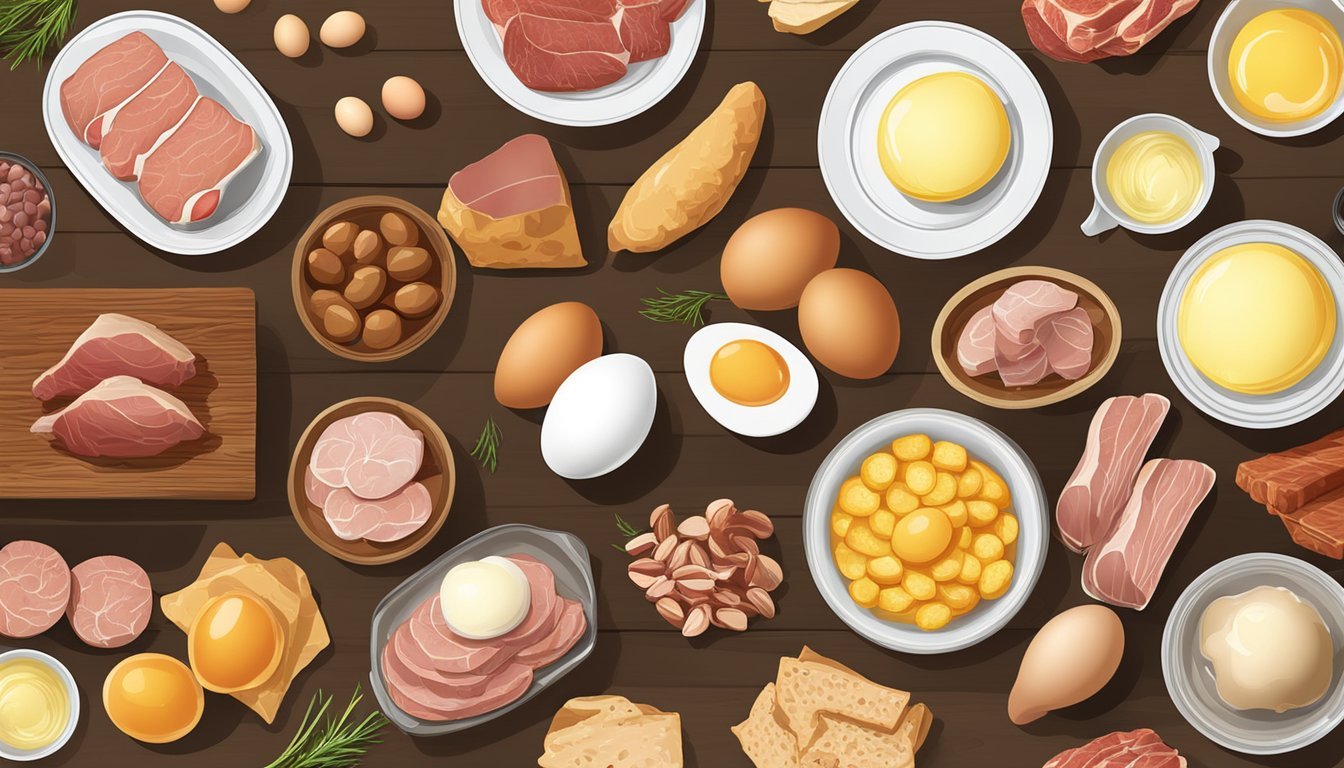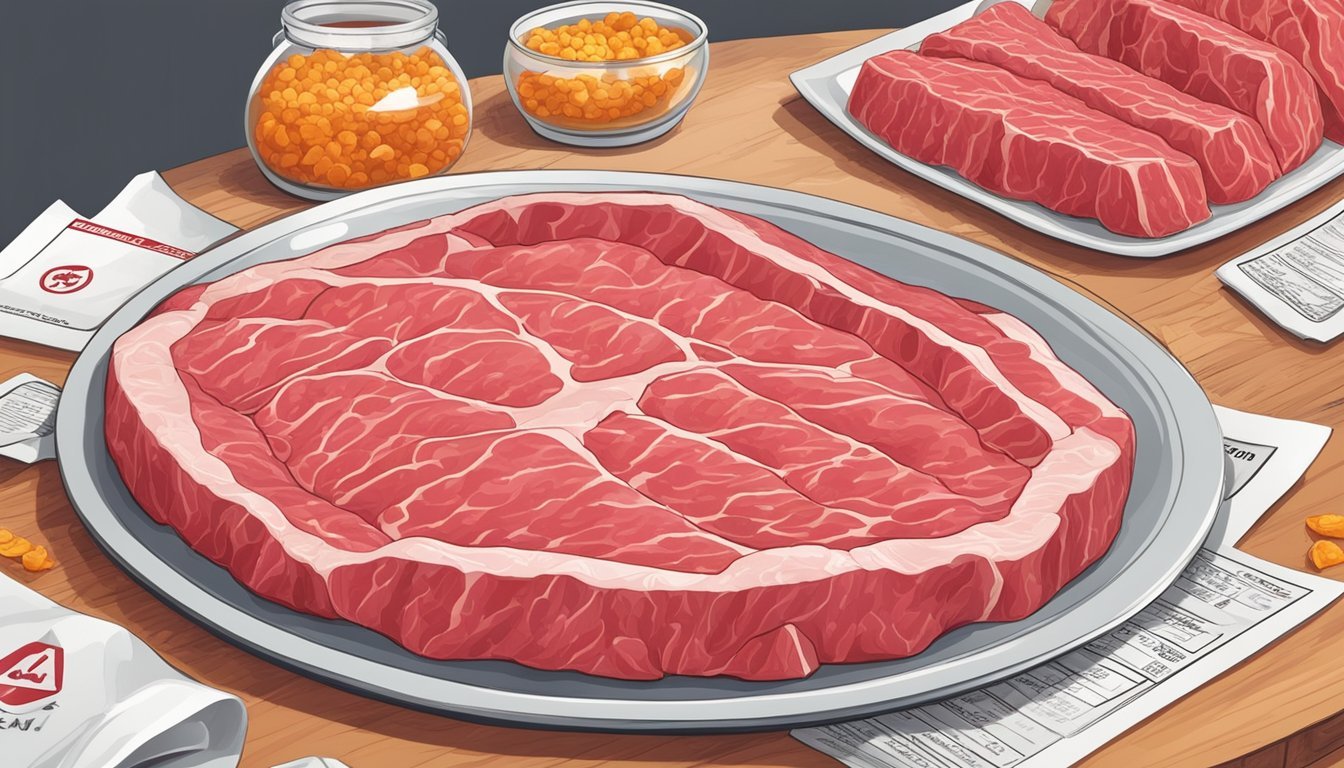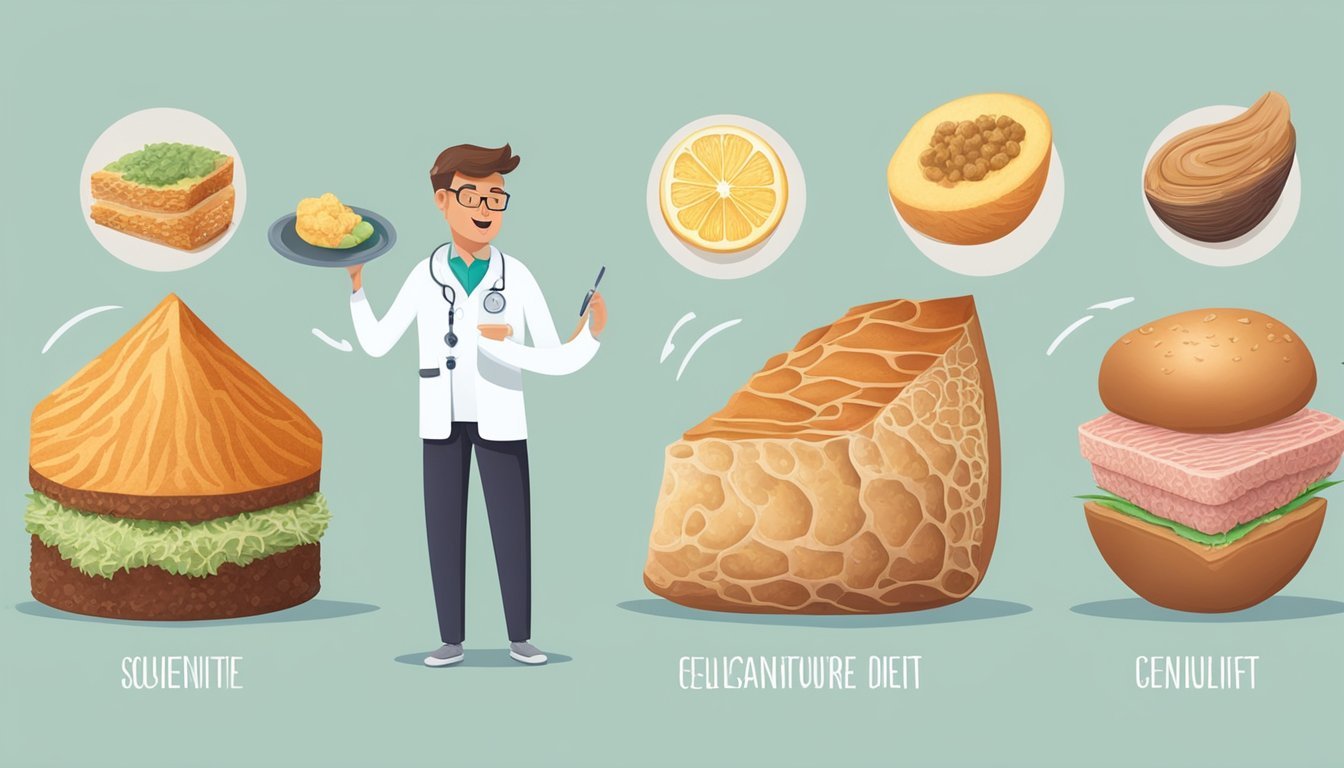Carnivore Diet Cellulite Reduction
Unveiling the Connection
This Article is Part Of Our Guide on the Carnivore Diet
The carnivore diet, a regimen that involves consuming only animal products and eliminating all plant-based foods, has garnered both support and controversy for its unconventional approach to nutrition. Advocates often attribute a variety of health benefits to this all-meat diet, including potential impacts on body composition and the appearance of cellulite. Cellulite, a common skin condition where the skin appears dimpled or lumpy, is often a cosmetic concern for many individuals regardless of body size or shape.
Research regarding the carnivore diet's effects on cellulite is sparse, as most dietary studies tend to focus on broader health outcomes rather than specific skin conditions. However, proponents of the diet theorize that the high protein and collagen intake from animal products may influence skin health and elasticity, potentially affecting the appearance of cellulite. Observational anecdotes from personal experiences, such as those shared on online forums, suggest varying impacts, with some individuals reporting no change and others claiming improvement in the texture of their skin.
Given the anecdotal nature of the evidence and the diet's deviation from traditional nutritional guidelines, it is important to approach claims about the carnivore diet and cellulite with a critical eye. Further scientific investigation is required to substantiate any potential relationship between the diet and cellulite reduction. Individuals interested in trying the carnivore diet for cellulite or other health benefits should consider consulting with healthcare professionals to ensure their nutritional needs are met and to discuss potential risks and benefits.
Carnivore Diet Basics
In this section, the reader will gain understanding of what the Carnivore Diet entails, the primary foods consumed, and how it compares to other low-carb diets.
Defining the Carnivore Diet
The Carnivore Diet is a dietary regimen that consists entirely of animal products. Unlike diets that incorporate a mix of plant and animal sources, this approach focuses solely on meats and animal byproducts, eliminating all plant-based foods. It is often considered a zero-carb diet, although some animal products may contain small amounts of carbohydrates.
Primary Foods in a Carnivore Diet
Meats form the cornerstone of the Carnivore Diet, with a strong emphasis on:
Red meats: beef, lamb, and pork
Poultry: chicken
Fish: a variety of both fatty and lean fish
Organ meats: heart, liver, and kidney
Beyond muscle meats, individuals may include:
Eggs: chicken, duck, goose
High-fat dairy products: butter and certain cheeses
Consumption of animal fats and saturated fats is prominent, with a focus on obtaining necessary fats for energy in the absence of carbohydrates.
Carnivore Diet vs. Other Low-Carb Diets
The Carnivore Diet differs from other low-carb diets, such as the ketogenic diet, in its exclusion of all plant-based foods. While both encourage high protein and fat intake, the ketogenic diet allows for limited carbohydrates, primarily from vegetables, nuts, and dairy. In contrast, the Carnivore Diet is often described as an all-encompassing zero-carb diet where the only source of energy is from animal products. This fundamental difference manifests in terms of food variety, nutritional approaches to health, and weight loss strategies.
Potential Health Benefits
The carnivore diet is noted for its potential in aiding weight management and improving certain health markers due to its high protein and low-carbohydrate approach.
Weight Management
Individuals often report weight loss on the carnivore diet, which may be attributed to its high protein content. The diet encourages satiety, which can reduce overall calorie intake.
Impact on Blood Sugar Levels
Because it eliminates carbohydrates, the carnivore diet may stabilize blood sugar levels, making it a point of consideration for individuals managing diabetes.
Anti-Inflammatory Effects
The exclusion of sugar and processed carbohydrates may reduce inflammation. Consuming nutrient-rich bone broth, a staple in this diet, is thought to have anti-inflammatory properties.
Digestive Health
By limiting food sources to meat, advocates suggest that the carnivore diet can aid in digestive health, due to the elimination of potentially irritating fibrous plant foods.
Mental Clarity and Focus
Consumers of the carnivore diet sometimes report increased mental clarity and focus. This may be related to stable blood sugar levels and the provision of steady energy from fats and proteins.
Muscle and Bone Strength
High intake of protein and nutrients like collagen could potentially contribute to muscle maintenance and bone strength. Bone broth, made from simmering bones to release collagen and other nutrients, is frequently consumed within this diet.
Nutritional Considerations
When exploring the carnivore diet in relation to cellulite, one must consider the diet's nutritional profile, including macronutrient distribution and micronutrient availability.
Macronutrient Profile
The carnivore diet focuses predominantly on meat and eliminates carbohydrates, including dietary fiber. This results in a high protein and fat intake, with negligible carbohydrates. The typical macronutrient distribution heavily favors these two macronutrients, which are essential for maintaining muscle mass and providing energy.
Vitamin and Mineral Content
Organ meats, such as liver and kidney, are potent sources of vitamins and minerals, including vitamin A, B vitamins, zinc, and iron. The inclusion of these foods is critical for a balanced nutrient intake on the carnivore diet. However, some vitamins and antioxidants, typically found in plant foods, might be less accessible.
Concerns with Nutrient Deficiency
A diet exclusively composed of meat can lead to concerns about deficiencies in certain nutrients, such as vitamin C and fiber. Nutrients that are less abundant in animal foods, such as certain omega-3 fatty acids and some minerals, should be monitored to avoid potential deficiencies.
The Role of Organs in Nutrition
Including a variety of organ meats is vital for obtaining a broad spectrum of nutrients. For instance, the liver is rich in vitamin A, iron, and B vitamins, while the kidney provides a source of vitamins and minerals critical to the body's functions. Omega-3 fatty acids are present in the fatty tissues of fish and should be considered for their anti-inflammatory properties.
Common Criticisms and Counterarguments
In this section, we explore prevalent critiques of the carnivore diet concerning nutritional balance and health risks, along with the counterarguments presented by proponents of the diet.
Lack of Fiber
Critics argue that the carnivore diet lacks dietary fiber, which is essential for digestive health. Fiber, found in plant-based foods, helps to regulate bowel movements and prevent constipation. They assert that long-term absence of fiber may lead to gastrointestinal issues.
Counterarguments:
Proponents claim that the carnivore diet can reduce inflammation in the gut, potentially offsetting the need for fiber. They point out that without plant matter, the gut has less fermentable material, which might reduce bloating and other digestive discomforts.
Risk of Chronic Diseases
The carnivore diet's high intake of animal products raises concerns about an increased risk of heart disease and cancer – conditions often linked to high saturated fat and red meat consumption.
Counterarguments:
Supporters reference individual accounts and some emerging studies suggesting that the diet can improve lipid profiles and reduce inflammatory markers. They argue that the scientific evidence linking red meat with chronic diseases is not as clear-cut as once thought, and that removing processed foods from the diet may mitigate health risks.
Long-Term Sustainability
Health experts question the long-term sustainability of the carnivore diet, given its restrictive nature and potential nutrient deficiencies that could arise from the elimination of entire food groups.
Counterarguments:
Enthusiasts of the carnivore diet assert that humans can thrive on an all-meat diet, as some indigenous populations have historically eaten primarily animal-based diets. They also suggest that many vitamin and mineral needs can be met through careful selection of organ meats and other nutrient-dense animal products.
Implementation Strategies
In addressing cellulite through a carnivore diet, the individual’s focus should be on adopting proper dietary habits in conjunction with physical activity to potentially influence body composition.
Transitioning to a Carnivore Diet
When an individual decides to switch to a carnivore diet, it's important to start gradually. They should eliminate one plant-based food group at a time and give their body a chance to adjust to the new way of eating. This elimination diet serves to pinpoint any adverse reactions and helps in adapting to a meat-centric dietary routine.
Daily Meal Planning
For meal planning, they need to incorporate a variety of animal-based products to ensure they are receiving a wide spectrum of nutrients. An effective meal plan could look like this:
Breakfast: Eggs and bacon
Lunch: Steak or animal organ meats
Dinner: Fatty fish such as salmon
They should include organ meats a few times a week due to their nutrient density.
Dealing with Cravings and Temptation
Handling cravings and temptation is crucial while on the carnivore diet. Individuals should be prepared with appropriate snack options, such as jerky or boiled eggs, to satiate any sudden hunger pangs. This is where mindful eating practices come into play, teaching them to differentiate between true hunger and habitual cravings.
Exercise and Physical Activity
Physical activity is vital for overall well-being and can aid in managing cellulite. Individuals should aim to incorporate a mix of resistance training and cardiovascular exercises into their weekly routine. For instance, they might implement a schedule like:
Monday
Activity: Resistance training
Wednesday
Activity: High-Intensity Interval Training (HIIT)
Friday
Activity: Resistance training
Sunday
Activity: Low-Intensity Steady State (LISS) cardio
This type of routine could assist an individual in maximizing muscle tone and enhancing fat loss.
Managing Side Effects
When adopting a carnivore diet, individuals may experience side effects that can be effectively managed with proper approaches. An understanding of these side effects and strategies for mitigation can promote a smoother dietary transition.
Addressing Constipation
Constipation can occur when individuals transition to a carnivore diet, due to the lack of fiber. To address this:
Hydration: Increase water intake to help soften stools.
Magnesium supplementation: Consider adding a magnesium supplement to aid in bowel movement regularity.
Mitigating 'Keto Flu' Symptoms
The 'keto flu' refers to symptoms experienced when one's body shifts from using carbohydrates to fats for energy, causing symptoms like headaches and fatigue.
Electrolyte balance: Ensure adequate intake of sodium, potassium, and magnesium to prevent imbalances.
Gradual transition: Slowly reduce carbohydrate intake to lessen the intensity of 'keto flu' symptoms.
Monitoring Cholesterol Levels
A carnivore diet can affect cholesterol levels, and individuals need to monitor these changes.
Regular blood tests: Obtain blood tests to monitor cholesterol and other markers.
Fatty acid profile: Opt for a balance of saturated and unsaturated fats to maintain a healthy lipid profile.
Carnivore Diet and Skin Health
The Carnivore diet's exclusion of carbohydrates and focus on proteins and fats might influence skin health, with implications for conditions like cellulite, skin elasticity, and acne.
Carnivore Diet's Impact on Cellulite
Cellulite, the dimpled skin typically present on thighs and buttocks, may be influenced by dietary habits. The Carnivore Diet, emphasizing high protein intake and low carbohydrates, could potentially affect the fat cells and connective tissue implicated in cellulite formation. Proponents suggest that a diet high in protein helps in the strengthening of connective tissues and fat metabolism, which could in turn reduce the appearance of cellulite.
Skin Elasticity and Collagen Production
Collagen, a critical protein for maintaining skin elasticity, may see production shifts influenced by dietary intake. The Carnivore Diet provides a rich supply of amino acids from meat, which are necessary for collagen synthesis. This could potentially improve skin tightness and elasticity, averting the sagging that contributes to the look of cellulite.
Potential Benefits for Acne and Skin Inflammation
Acne and skin inflammation may be responsive to dietary changes. Anecdotal evidence indicates that the high levels of omega-3 fatty acids in foods like salmon—common in the Carnivore Diet—can reduce inflammation. By eliminating sugar and dairy, two food groups often linked to acne, the Carnivore Diet might alleviate the inflammatory response in the skin, lessening acne breakouts.
Lifestyle Considerations
When adopting a carnivore diet, individuals need to take into account the changes such a diet will require in various aspects of daily life, particularly in terms of socializing, budgeting, and managing family meals.
Social and Dining Out
He or she may find that social events and dining out present challenges, as the carnivore diet is restrictive and mainly focuses on animal products. Social life can be affected as most restaurants cater to a variety of dietary preferences, with limited carnivore-specific options.
Restaurants: One may need to request custom meals like steak or seafood without sides.
Events: At social gatherings, it's prudent to plan ahead or eat beforehand.
Cost and Accessibility
The cost of a carnivore diet can be higher due to the reliance on meat, which is generally more expensive than plant-based foods. Price points vary widely based on the type of meat and cuts chosen.
Budgeting: To manage costs, one could buy in bulk or choose less expensive cuts.
Shopping: Accessibility to a wide range of meats at local markets can influence dietary variety.
Balancing Family Diets
If a family isn't entirely on board with the carnivore diet, one may need to prepare separate meals or incorporate the diet's principles into the family's existing dietary preferences.
Inclusion: Simple adjustments, like preparing a meat dish that can be eaten with or without plant sides, can help.
Nutrition: Ensuring that all family members, especially children, receive balanced nutrition is crucial.
Success Stories and Anecdotal Evidence
Success stories of individuals on the carnivore diet often highlight significant weight loss and transformative health benefits. These anecdotes provide personal perspectives on the diet's impact, particularly in regards to body composition changes such as the reduction of cellulite.
One such narrative involves Brian Nowicki, who reportedly lost 80 pounds and experienced notable health improvements after adopting a carnivore diet. His transition is depicted through before and after photos, showcasing the physical changes attributed to his dietary shift.
Individual: Brian Nowicki
Weight Loss: 80lbs
Health Benefits: Improved overall health
These accounts consistently describe an all-animal food menu, including:
Meat (beef, pork, poultry)
Seafood
Eggs
Proponents assert that these foods can lead to a feeling of fullness, possibly aiding in weight management. They often experience a simplification in dietary choices, as the carnivore diet eliminates plant-based foods entirely.
Health benefits beyond weight reduction, such as improvements in energy levels and mental clarity, are frequently mentioned in personal stories. However, it's important to note that these outcomes are anecdotal and vary from person to person.
The anecdotal evidence available points to a trend among followers who report positive changes. While these testimonies provide insight into potential benefits, they are not to be substituted for scientific research or medical advice.
Potential Risks and Concerns
When considering the carnivore diet and its effects on cellulite, one must weigh the risks associated with the high intake of certain nutrients and the exclusion of others.
Excess Saturated Fat Intake
A diet consisting predominantly of animal products will inevitably lead to heightened saturated fat consumption. Saturated fats are found in foods such as red meat, butter, and cheese. High intake of these fats can raise LDL (bad) cholesterol levels in the blood, which is a risk factor for heart disease and stroke.
Possible Nutritional Imbalances
The restrictive nature of the carnivore diet, which eliminates plant-based foods, may result in nutrient deficiencies. Among these are:
Vitamin C: Typically found in fruits and vegetables, its absence can lead to scurvy.
Fiber: Essential for digestive health, fiber is absent in animal products, which may cause constipation or other digestive issues.
Some minerals and vitamins: A lack of variety in the diet can mean insufficient intake of nutrients like calcium and potassium.
Long-term Health Implications
Long-term adherence to a carnivore diet may pose several health risks, such as:
Increased risk of chronic diseases: Due to high levels of saturated fat and potential imbalances in nutrients.
Impact on organ function: The strain on kidneys from processing high levels of protein and the lack of detoxifying plant compounds can affect organ health.
Potential exacerbation of existing conditions: Individuals with conditions like heart disease may find that the diet worsens their health issues.
Scientific Research
This section examines the available scientific evidence on the carnivore diet's impact on cellulite through clinical studies, expert analyses, and areas where data is presently insufficient.
Clinical Studies and Reviews
Clinical research on the carnivore diet's effect on celluloid is limited. However, some studies suggest that the diet may have implications for skin health due to its high protein content. Protein plays a role in the repair and maintenance of body tissues, including skin, which may influence cellulite appearance. No direct studies have yet established a conclusive link between the carnivore diet and changes in cellulite.
Study Focus: Skin Health
Findings: Potential benefits of protein for tissue repair.
Study Focus: Diet Impact
Findings: Need for direct research on the diet-cellulite relationship.
Expert Opinions
Dermatologists and nutrition experts suggest that diets high in certain nutrients can impact skin health. While not specific to the carnivore diet, these experts emphasize balanced nutrition for optimum skin conditions. They also note that cellulite, which is affected by factors like genetics and lifestyle, may not be significantly altered by dietary changes alone.
Nutritional Balance: Experts advocate for a diet inclusive of various nutrients beyond what a carnivore diet typically provides.
Lifestyle Factors: Emphasis on the complex nature of cellulite that transcends dietary influences.
Areas Lacking Evidence
The majority of research on cellulite does not specifically address the carnivore diet. Current scientific evidence does not offer definitive conclusions on its effects on cellulite. The field would benefit from further research targeting the correlation between a strict carnivore diet and skin health, particularly in relation to cellulite.
Direct Impact Studies: A gap in research on the carnivore diet's direct effect on cellulite.
Longitudinal Data: A need for long-term studies tracking cellulite changes with dietary patterns.
Conclusion
The investigation into the effects of the carnivore diet on cellulite reveals a complex interaction. While direct evidence linking this diet to cellulite reduction is limited, certain factors such as weight loss, hormonal balance, and collagen production may contribute to improvements in skin appearance.
Body composition changes from a high-protein carnivore diet could lead to fat loss, potentially diminishing the visibility of cellulite. Additionally, the diet's impact on fluid balance and collagen may alter skin structure and firmness.
Users of the carnivore diet report a range of experiences. Some claim benefits in skin texture, while others do not observe significant changes to cellulite. Given that cellulite arises from fat deposits pushing through connective tissue, enhancements in muscle tone and skin elasticity from a carnivore diet could offer marginal benefits.
Carnivore Diet: May influence skin health by promoting fat loss and collagen synthesis.
Cellulite Response: Individual experiences vary, and improvements, if any, are not guaranteed.
Scientific Backing: Robust, conclusive studies on the diet's impact on cellulite are scarce.
Individuals considering the carnivore diet for cellulite reduction should consult healthcare professionals. Nutritionists can provide guidance tailored to personal health profiles. Keeping expectations realistic and considering the diet's nutritional implications is crucial, as is recognizing that it's one aspect of a multifaceted approach to skin health.












